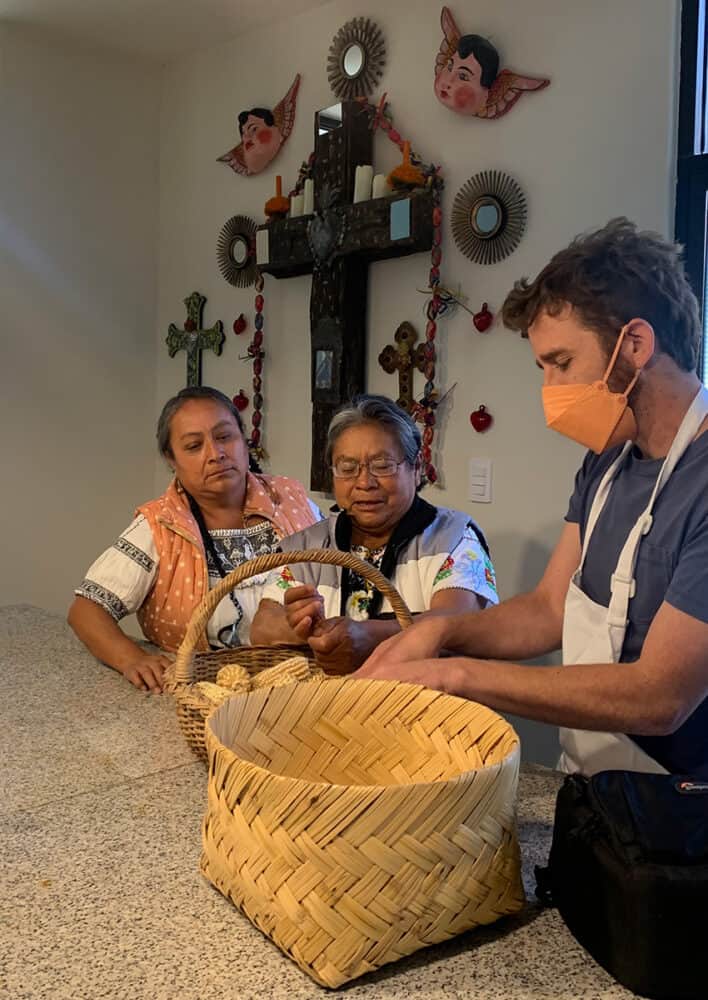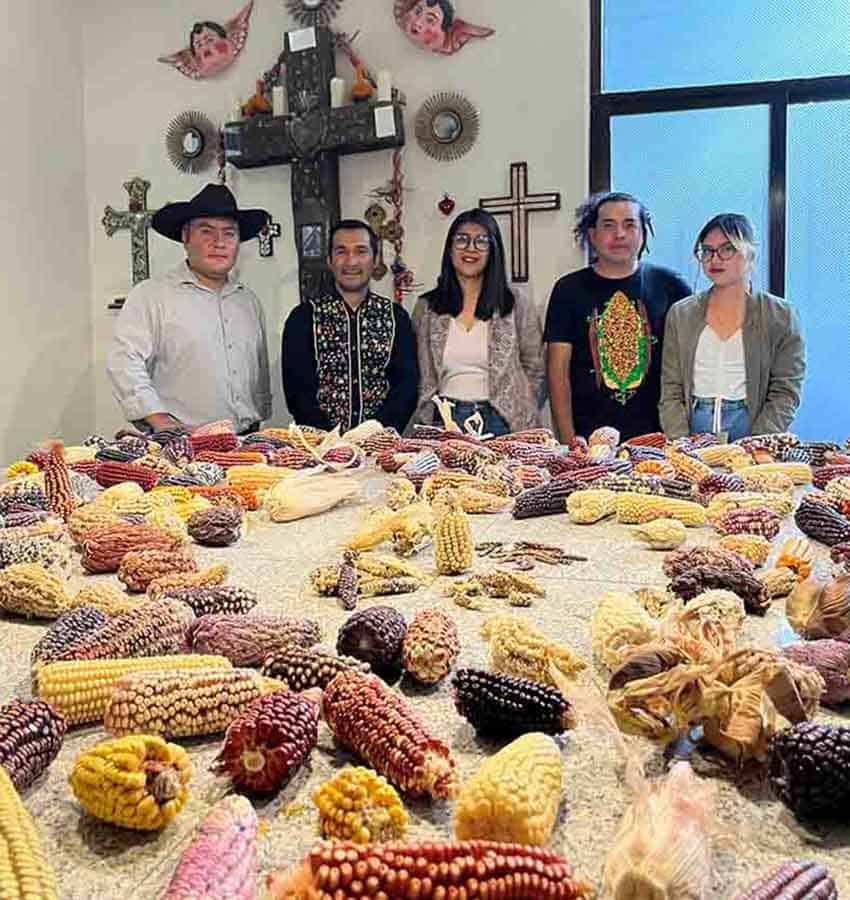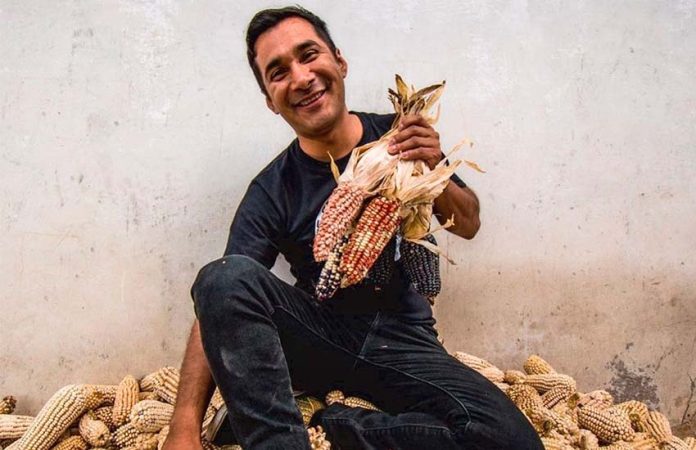Mexican chef Irad Santa Cruz dreamed of making pastries in Spain, but when he got to culinary school in Valencia, his classmates tested him with some questions he wasn’t expecting about where he came from.
What’s special about regional cuisine from Tlaxcala, they asked? What are its most abundant ingredients?
He had to admit to them, and himself, that he didn’t know the answers.
“Discussing Tlaxcala is tough because if locals barely know anything about it, other Mexicans don’t even know where Tlaxcala is!” Santa Cruz says of his home state.

He decided to return home to discover the cuisine of his birthplace. That process, which began in the kitchen with his childhood nanny and mother, ended up connecting him to traditional cooks across the region.
As he was introduced from señora to señora, he asked them for traditional recipes and gave them pastry-making classes in exchange. He met sisters Silvia and Ángela, who had over 125 varieties of heritage corn growing on their land. He hunted maguey worms and Chicatana ants with local insect experts and wild mushrooms with fungi connoisseurs. And he recorded it all down in slim notebook after slim notebook.
“I met with some traditional cooks … and they said to me, ‘Ah, we make this dish with this specific ingredient, but we don’t have that ingredient anymore.’ I realized that cuisine isn’t just food, cuisine is also ingredients,” Santa Cruz said. “It’s also utensils, people, physical spaces, tips, secrets, techniques. Food is the final product or the goal, but everything around cuisine is various actors and factors. …. if there’s no ingredients, there’s no cuisine.”
“I said to myself, ‘I have to go back to nature and get to know the ingredients.’ And I started to research,” he said.
Along the way, the Centro de Investigación de la Cocina Tlaxcalteca (Tlaxcala Cuisine Research Center) in Tlaxcala city was born.
It’s a mix of a cultural center, a cooking school and an archive, where Santa Cruz and his fellow foodie Edgar have a freezer full of local wild mushroom varieties, jars of alcohol-encased edible bugs and ears of corn the likes of which you have never seen, no matter how many trips to Mexican markets you’ve taken: blue corn that’s almost black with pink husks; “Veins of Christ” corn in creamy yellow-white with magenta stripes; “garlic” corn that has each kernel wrapped in its own tiny husk.
Each addition to the collection is the result of a network of relationships Santa Cruz has been building over the last 12 years with local farmers.
“We go to the places and see firsthand what the collection of these ingredients is like. We like to go to the site and connect with the pure essence of the place to get to know how it is, to experience the entire context,” said Santa Cruz. “Because sometimes products just arrive at our tables, and we never know all the labor and work behind them.”

This August, the center officially opened its doors to the public, offering culinary and learning experiences to showcase the area’s vast biodiversity and its ancestral knowledge. Scattered around the main room is local, handmade pottery, an artistic homage to the tortilla hanging on the wall and photos of Santa Cruz with various Catholic popes on their tours through Mexico.
There are also several massive binders of regional recipes painstakingly collected that Santa Cruz will bring out proudly if asked.
“One of the señoras would simply say, ‘Like this, like a handful,‘” he recounts about recipe collecting. “They were almost like empirical recipes that were given to me, and I would just write them down. I realized that you couldn’t replicate something like that because your handful isn’t the same as my handful.
“So I invited the cooks here to my kitchen, and we started to do something we call ‘to testify.’ That means from what they taught me, I would make the dish, and the person who gave me the recipe would approve or reject [the final product].”
For a chef who once dreamed of making European-style confections, Santa Cruz has sunk deeply and wholeheartedly back into his roots. Part of his mission now is finding ways to connect big-city chefs with small-town farmers for the mutual benefit of both. In fact, that’s how I met him.
I was given his name by Elena Reygadas, one of Mexico’s most well-known chefs and owner of the award-winning Rosetta restaurant in the Roma Norte neighborhood of Mexico City. The day I met her, she waxed poetic about a particular collector of honeypot ants that Santa Cruz had introduced her to the last time the insects were in season.
She told me that I had to connect with him.
Santa Cruz is a go-between, a “conductor,” he insists, preferring the term to what he feels is the more pejorative “intermediary” because he takes no cut from the business dealings between farmers and chefs.
Instead, like a culinary Cupid, he is hoping that his work will highlight the ingredients of his home state in dining rooms across the country.

“My concern is only that they meet each other and that the farmer knows that they have something of special value in an industry that needs them and that the industry has the economic wherewithal to pay that farmer a fair price,” Santa Cruz said. “If the price is fair, the farmers won’t quit farming, and the chef will be able to say, ‘I have the very best product.’”
Opening the research center to the wider public is sure to expand the network he has already created, and when he finds a sponsor for the printing of his recipe book, he’s sure it will crack Tlaxcala cuisine open to the wider world.
Even so, he said, he’s not anywhere close to done.
“I have only been to about a third of the state, not even half,” he explained. “It’s been 15 years and we haven’t even gotten to half of the smallest state in Mexico! We want Mexicans and the world to know about [what’s here], to feel it, to know that it’s true, that it exists, that it’s alive, that it’s current and that if we don’t take care of it, this heritage is going to disappear.”
- To visit the Centro de Investigación de la Cocina Tlaxcalteca and find out how to take classes there, contact them on Instagram or Facebook or via email at [email protected].
